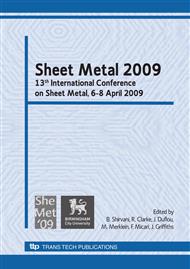p.271
p.279
p.289
p.297
p.305
p.315
p.325
p.335
p.347
Investigation Mechanism of V-Ring Indenter Geometry in Fine-Blanking Process
Abstract:
The V-ring indenter geometry (angle, height and position) was investigated by using the finite element method (FEM) to theoretically clarify the mechanism and its action in the fine-blanking process. The FEM simulation results indicate that very small or very large V-ring indenter angles, heights, and positions cause difficulty in the rotation of the material-flow and that the hydrostatic pressure is generated with great difficulty in the blanked material; therefore, crack formation occurs easily. The application of a suitable V-ring indenter angle, height, and position significantly suppresses the formation of rotating flow, which results in increased hydrostatic pressure, and crack formation is consequently prevented.
Info:
Periodical:
Pages:
305-312
Citation:
Online since:
March 2009
Authors:
Keywords:
Price:
Сopyright:
© 2009 Trans Tech Publications Ltd. All Rights Reserved
Share:
Citation:


